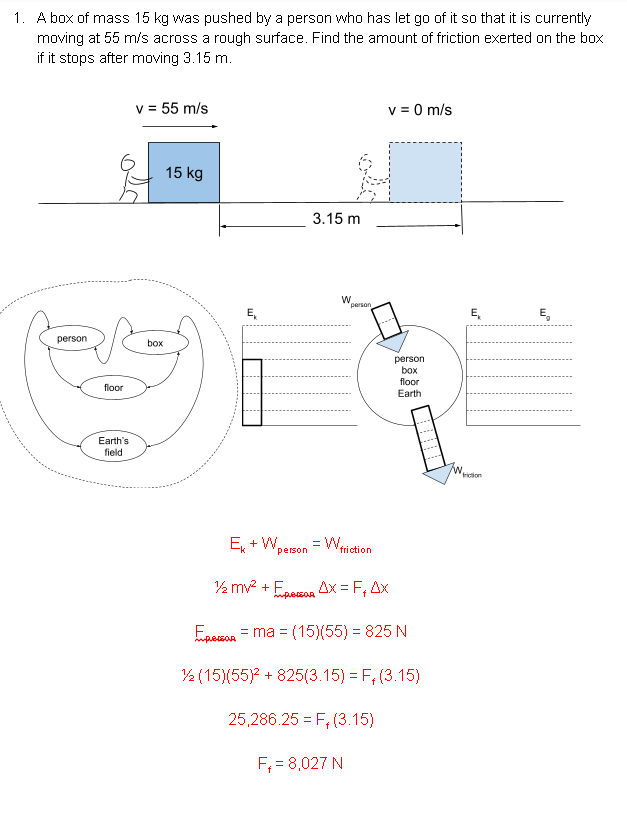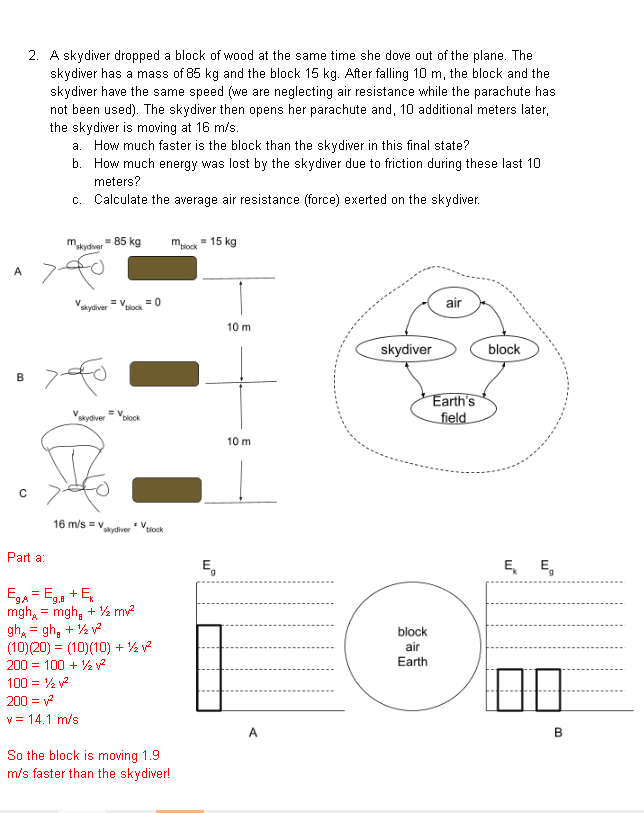A box of mass 15 kg was pushed by a person who has let go of it so that it is currently moving at 55 m/s across a rough surface. Find the amount of friction exerted on the box if it stops after moving 3.15 m. v = 55 m/s v = 0 m/s 15 kg 3.15 m
A box of mass 15 kg was pushed by a person who has let go of it so that it is currently moving at 55 m/s across a rough surface. Find the amount of friction exerted on the box if it stops after moving 3.15 m. v = 55 m/s v = 0 m/s 15 kg 3.15 m
Physics for Scientists and Engineers, Technology Update (No access codes included)
9th Edition
ISBN:9781305116399
Author:Raymond A. Serway, John W. Jewett
Publisher:Raymond A. Serway, John W. Jewett
Chapter5: The Laws Of Motion
Section: Chapter Questions
Problem 5.41P: Figure P5.41 shows the speed of a persons body as he does a chin-up. Assume the motion is vertical...
Related questions
Question
Problems 1 and 2 were done incorrectly. Correct the mistakes made and find the real solutions to the problems. Find the solution to Problem 3.

Transcribed Image Text:1. A box of mass 15 kg was pushed by a person who has let go of it so that it is currently
moving at 55 m/s across a rough surface. Find the amount of friction exerted on the box
if it stops after moving 3.15 m.
v = 55 m/s
v = 0 m/s
15 kg
3.15 m
W.
"person
E,
E,
E,
person
box
person
box
floor
floor
Earth
Earth's
field
iion
E + W,
person
friction
½ mv? + Epesoa Ax = F, Ax
Ensson = ma = (15)(55)% 3D 825 N
2 (15)(55)? + 825(3.15) = F, (3.15)
25,286.25 = F, (3.15)
F; = 8,027 N

Transcribed Image Text:2. A skydiver dropped a block of wood at the same time she dove out of the plane. The
skydiver has a mass of 85 kg and the block 15 kg. After falling 10 m, the block and the
skydiver have the same speed (we are neglecting air resistance while the parachute has
not been used). The skydiver then opens her parachute and, 10 additional meters later,
the skydiver is moving at 16 m/s.
a. How much faster is the block than the skydiver in this final state?
b. How much energy was lost by the skydiver due to friction during these last 10
meters?
c. Calculate the average air resistance (force) exerted on the skydiver.
makydiver
= 85 kg
miock" 15 kg
A
Vaydiver = Valock = 0
air
10 m
skydiver
block
B
Earth's
field
skydiver block
10 m
16 m/s = v
skydiver
Vtiock
Part a:
E,
E, E,
Ega = Ega + E,
mgh, = mgh, + ½ mv
gh, = gh, + % ?
(10)(20) = (10)(10) + ½ ?
200 = 100 + ½
100 = ½
200 = v2
v = 14.1 m/s
g.8
block
air
Earth
A
в
So the block is moving 1.9
m/s faster than the skydiver!
Expert Solution
This question has been solved!
Explore an expertly crafted, step-by-step solution for a thorough understanding of key concepts.
Step by step
Solved in 3 steps with 2 images

Knowledge Booster
Learn more about
Need a deep-dive on the concept behind this application? Look no further. Learn more about this topic, physics and related others by exploring similar questions and additional content below.Recommended textbooks for you

Physics for Scientists and Engineers, Technology …
Physics
ISBN:
9781305116399
Author:
Raymond A. Serway, John W. Jewett
Publisher:
Cengage Learning

College Physics
Physics
ISBN:
9781285737027
Author:
Raymond A. Serway, Chris Vuille
Publisher:
Cengage Learning

Principles of Physics: A Calculus-Based Text
Physics
ISBN:
9781133104261
Author:
Raymond A. Serway, John W. Jewett
Publisher:
Cengage Learning

Physics for Scientists and Engineers, Technology …
Physics
ISBN:
9781305116399
Author:
Raymond A. Serway, John W. Jewett
Publisher:
Cengage Learning

College Physics
Physics
ISBN:
9781285737027
Author:
Raymond A. Serway, Chris Vuille
Publisher:
Cengage Learning

Principles of Physics: A Calculus-Based Text
Physics
ISBN:
9781133104261
Author:
Raymond A. Serway, John W. Jewett
Publisher:
Cengage Learning

College Physics
Physics
ISBN:
9781305952300
Author:
Raymond A. Serway, Chris Vuille
Publisher:
Cengage Learning

College Physics
Physics
ISBN:
9781938168000
Author:
Paul Peter Urone, Roger Hinrichs
Publisher:
OpenStax College

University Physics Volume 1
Physics
ISBN:
9781938168277
Author:
William Moebs, Samuel J. Ling, Jeff Sanny
Publisher:
OpenStax - Rice University